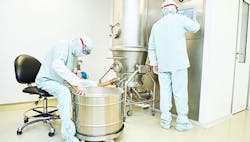Solids Processing: Understand How Drying And Dust Interact
We live in the mountains of Colorado in the summer. I’m amazed at how much we are surrounded by solids processing operations. First, there is intense sunshine that can dry a deck in under an hour, or cook your skin in less than a minute. (Actually, as I mentioned in my previous column, “Dry Your Solids Properly,” it’s not the heat but the vapor pressure that determines the drying rate.) Second, there are dust storms that demonstrate the efficiency of a cyclone in capturing dust. (The suction created by the lowest pressure is at the bottom of the cyclone.) Finally, there is the coating of larger particles that makes for slippery walkways even without rain.
We are surrounded by crystallization, solid/liquid separation and drying processes, not to mention the agglomeration and attrition that occur on gravel roads. When I see a fluid bed dryer, these analogies come bursting out — especially the issues of dust control. What most people like about a non-fluidization operation is a much-simpler dust control step. For example, consider a drum dryer. You may need only a very small amount of gas to carry off the solvent because the solids are heated by conduction. Often, the amount of dust not only is very low but also the particles easily drop back into the dry product. However, you must do a mass balance to ensure the gas flow provides an adequate safety margin to carry all the moisture out and you don’t inadvertently condense the solvent. I got a call along this line where the engineer assured me the plant had plenty of gas flow. However, the relative humidity of the gas was close to 90% at the discharge to a filter that was un-insulated. You can guess what happened. If you plan to operate at high exit humidity, a better choice for dust control is a wet scrubber. You even may use wash liquor from the solid/liquid separation to capture the dust as product.
Fluid bed dryers avoid the humidity issue because they supply an excess of gas to heat the product. You can get into trouble when using internal bed heating and have the same problem as the drum dryer example.
Dust control in industrial dryers is much more difficult than dust control on a pneumatic or belt conveyor because of possible solvent condensation. In addition, you must expect some attrition; these fine particles can be troublesome. An example is the handling of fines in a fluid bed. I was called to a plant because a fluid bed would run for ≈2–3 h before the bed collapsed and plugged everything up. Raising the gas flow made the problem worse because it increased attrition. The plant used a batch fluid bed that had been converted to run continuously. The bag filter was built into the dryer body and fine particles dropped back into the bed. This reduced the average particle size of the bed; only a small portion of the fines was going out with the larger particles. This continued until the gas no longer could support the mass of solids. Relocating the bag filter outside the dryer and dropping the fine solids into the product discharge solved the problem.
You can learn a lot by observing Mother Nature. We live near a water park on a river. The kayakers can go upstream against what appears to be a strong current by taking advantage of a low pressure area behind a boulder. I was reminded of a case where we were having erosion inside a distributor that had no solids in the gas. We built a model and were able to visualize what was happening. (Note: we didn’t have computational fluid dynamics software then.) Even though the velocity through the jets was over 100 ft/s, we could see a reverse flow occurring around the edges of the jet (a low pressure area) that drew in solids from above. These subsequently went through the jet, eroding it. A slight change in the jet configuration eliminated this reverse flow.
Dust control issues can show up in many other parts of solids processing such as conveying and handling operations, which is the subject of the next column.
About the Author
Tom Blackwood, Solids Advice columnist
Contributing Editor
Tom Blackwood, a veteran engineer who has dealt extensively with solids over the course of his career, contributes regularly to Chemical Processing and serves as the Solid Advice columnist.

